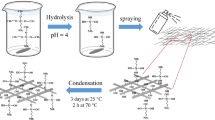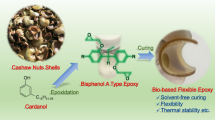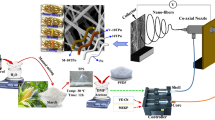Abstract
We prepared epoxidized soybean oil (ESO) grafted with carboxyl-terminated poly(acrylonitrile-co-butadiene) (CTBN) (ESO-g-CTBN) by a ring-opening reaction between the epoxide group and the carboxyl group. The structural features of the resulting product were determined using modern analytical techniques, such as Fourier transform infrared (FTIR) spectroscopy, proton nuclear magnetic resonance (1H NMR) spectroscopy, and gel permeation chromatography (GPC). The ESO-g-CTBN was applied as a toughener for an epoxy resin-based composite that was fabricated by blending the epoxy resin with diethylenetriamine (DETA) as the curing agent. The main aim of this procedure is to simultaneously improve the mechanical properties and fracture toughness of a bisphenol A-based epoxy resin. When 15 phr of ESO-g-CTBN was added to the EP/DETA mixture, the resin fracture toughness (KIC) and tensile strength increased from 0.65 to 1.09 MPa m1/2 and from 34.42 to 42.55 MPa, respectively. The ESO-g-CTBN existed in the EP matrix as a separate phase and induced an increase in the KIC via stopping crack growth or changing the crack direction.
This is a preview of subscription content, access via your institution
Access options
Subscribe to this journal
Receive 12 print issues and online access
$259.00 per year
only $21.58 per issue
Buy this article
- Purchase on Springer Link
- Instant access to full article PDF
Prices may be subject to local taxes which are calculated during checkout















Similar content being viewed by others
References
Lee JKY, Chen N, Peng S, Li L, Tian L, Thakor N, et al. Polymer-based composites by electrospinning: preparation & functionalization with nanocarbons. Prog Polym Sci. 2018;86:40–84.
Foard JHD, Rollason D, Thite AN, Bell C. Polymer composite Belleville springs for an automotive application. Compos Struct. 2019;221:110891.
Akhtar S, Saad M, Pandey P. Overview of current advances in the development of polymer composite in biomedical applications. Mater Today Proc. 2018;5:20217–23.
Sharma J, Arya RK, Verros GD. A unified model for the drying of glassy polymer coatings. Prog Org Coat. 2019;134:219–25.
Sarikaya E, Çallioğlu H, Demirel H. Production of epoxy composites reinforced by different natural fibers and their mechanical properties. Compos B Eng. 2019;167:461–6.
Vu CM, Nguyen DD, Sinh LH, Pham TD, Pham LT, Choi HJ. Environmentally benign green composites based on epoxy resin/bacterial cellulose reinforced glass fiber: fabrication and mechanical characteristics. Polym Test. 2017;61:150–61.
Vu CM, Sinh LH, Nguyen DD, Thi HV, Choi HJ. Simultaneous improvement of the fracture toughness and mechanical characteristics of amine-functionalized nano/micro glass fibril-reinforced epoxy resin. Polym Test. 2018;71:200–8.
Vu CM, Sinh LH, Choi HJ, Pham TD. Effect of micro/nano white bamboo fibrils on physical characteristics of epoxy resin reinforced composites. Cellulose. 2017;24:5475–86.
Lee M, Kwon W, Kwon D, Lee E, Jeong E. Fracture toughness of the novel in-situ polytriazolesulfone modified epoxy resin for carbon fiber/epoxy composites. J Ind Eng Chem. 2019;77:461–9.
Cai S, Li Y, Liu HY, Mai YW. Effect of electrospun polysulfone/cellulose nanocrystals interleaves on the interlaminar fracture toughness of carbon fiber/epoxy composites. Compos Sci Tech. 2019;181:107673.
Vu CM, Choi HJ. Enhancement of interlaminar fracture toughness of carbon fiber/epoxy composites using silk fibroin electrospun nanofibres. Polym Plast Tech Eng. 2016;55:1048–56.
Dittanet P, Pearson RA. Effect of bimodal particle size distributions on the toughening mechanisms in silica nanoparticle filled epoxy resin. Polym. 2013;54:1832–45.
Vu. CM, Choi HJ. Fracture toughness and surface morphology of micro/nano sized fibrilsmodified epoxy resin. Polym Sci A. 2016;58:464–70.
Pham TD, Vu CM, Choi HJ. Enhanced fracture toughness and mechanical properties of epoxy resin with rice husk-based nano-silica. Polym Sci A. 2017;59:437–44.
Wang L, Tan Y, Wang H, Gao L, Xiao C. Investigation on fracture behavior and mechanisms of DGEBF toughened by CTBN. Chem Phys Lett 2018;699:14–21.
Srivastava K, Rathore AK, Srivastava D. Studies on the structural changes during curing of epoxy and its blend with CTBN. Spectrochim Acta A Mol Biomol Spectrosc. 2018;188:99–105.
Chen J, Kinloch AJ, Sprenger S, Taylor AC. The mechanical properties and toughening mechanisms of an epoxy polymer modified with polysiloxane-based core-shell particles. Polym. 2013;54:4276–89.
Liu S, Fan X, He C. Improving the fracture toughness of epoxy with nanosilica-rubber core-shell nanoparticles. Compos Sci Tech. 2016;125:132–40.
Han W, Chen S, Campbell J, Zhang X, Tang Y. Fracture toughness and wear properties of nanosilica/epoxy composites under marine environment. Mater Chem Phys. 2016;177:147–55.
Li J, Zhu W, Zhang S, Gao Q, Li J, Zhang W. Amine-terminated hyperbranched polyamide covalent functionalized graphene oxide-reinforced epoxy nanocomposites with enhanced toughness and mechanical properties. Polym Test. 2019;76:232–44.
Vijayan PP, Puglia D, Maadeed MAS, Kenny JM, Thomas S. Elastomer/thermoplastic modified epoxy nanocomposites: the hybrid effect of ‘micro’ and ‘nano’ scale. Mater Sci Eng: R: Rep. 2017;116:1–29.
Nguyen LT, Vu CM, Phuc BT, Tung NH. Simultaneous effects of silanized coal fly ash and nano/micro glass fiber on fracture toughness and mechanical properties of carbon fiber‐reinforced vinyl ester resin composites. Polym Eng Sci. 2019;59:584–91.
Bach QV, Vu CM, Vu HT, Nguyen DD. Enhancing mode I and II interlaminar fracture toughness of carbon fiber-filled epoxy-based composites using both rice husk silica and silk fibroin electrospun nanofibers. High Perform Polym. 2019; https://doi.org/10.1177/0954008319840404.
Fernandes FC, Kirwan K, Lehane D, Coles SR. Epoxy resin blends and composites from waste vegetable oil. Eur Polym J. 2017;89:449–60.
Sharmin E, Zafar F, Akram D, Alam M, Ahmad S. Recent advances in vegetable oils based environment friendly coatings: a review. Ind Crop Prod. 2015;76:215–29.
Yim YJ, Rhee KY, Park SJ. Fracture toughness and ductile characteristics of diglycidyl ether of bisphenol-A resins modified with biodegradable epoxidized linseed oil. Compos B Eng. 2017;131:144–52.
Park SJ, Jin FL, Lee JR. Thermal and mechanical properties of tetrafunctional epoxy resin toughened with epoxidized soybean oil. Mater Sci Eng A. 2004;374:109–14.
Kumar S, Samal SK, Mohanty S, Nayak SK. Epoxidized soybean oil-based epoxy blend cured with anhydride-based cross-linker: thermal and mechanical characterization. Ind Eng Chem Res. 2017;56:687–98.
Zhang J, Deng S, Wang Y, Ye L. Role of rigid nanoparticles and CTBN rubber in the toughening of epoxies with different cross-linking densities. Compos A Appl Sci Manuf. 2016;80:82–94.
Mansour G, Tsongas K, Tzetzis D. Investigation of the dynamic mechanical properties of epoxy resins modified with elastomers. Compos B Eng. 2016;94:152–9.
Vu CM, Nguyen LT, Nguyen TV, Choi HJ. Effect of additive-added epoxy on mechanical and dielectric characteristics of glass fiber reinforced epoxy composites. Polym. 2014;38:726–34.
Park SJ, Jin FL, Lee JR. Effect of biodegradable epoxidized castor oil on physicochemical and mechanical properties of epoxy resins. Macromol Chem Phys. 2004;205:2048–54.
Yu JW, Jung J, Choi YM, Choi JH, Yu J, Lee JK, et al. Enhancement of the crosslink density, glass transition temperature, and strength of epoxy resin by using functionalized graphene oxide co-curing agents. Polym Chem. 2016;7:36–43.
Acknowledgements
This research was funded by the Vietnam National Foundation for Science and Technology Development (NAFOSTED) under grant number 104.02–2017.15.
Author information
Authors and Affiliations
Corresponding author
Ethics declarations
Conflict of interest
The authors declare that they have no conflict of interest.
Additional information
Publisher’s note Springer Nature remains neutral with regard to jurisdictional claims in published maps and institutional affiliations.
Rights and permissions
About this article
Cite this article
Bach, QV., Vu, C.M., Vu, H.T. et al. Epoxidized soybean oil grafted with CTBN as a novel toughener for improving the fracture toughness and mechanical properties of epoxy resin. Polym J 52, 345–357 (2020). https://doi.org/10.1038/s41428-019-0275-3
Received:
Revised:
Accepted:
Published:
Issue Date:
DOI: https://doi.org/10.1038/s41428-019-0275-3
This article is cited by
-
Simultaneous Influence of Silanized Bio-Silica and Graphene Oxide on the Mechanical characteristics and Fracture Toughness of Synthesized Epoxidized Soybean Oil
Silicon (2023)
-
Performance evaluation of newly developed environmentally friendly metalworking fluids during grinding
Biomass Conversion and Biorefinery (2023)
-
Enhanced mechanical properties and flame retardant of epoxy resin by using of GOPOS decorated MWCNTs
Polymer Bulletin (2022)
-
Novel CuSiF6-coordinated epoxy–amine composites with reduced combustibility: Elaboration, thermal-oxidative behavior, and ignition susceptibility
Polymer Bulletin (2022)
-
Properties of bio-based thermosetting composites synthesized from epoxidized soybean oil and azo-cardanol benzoxazine
Journal of Polymer Research (2021)



